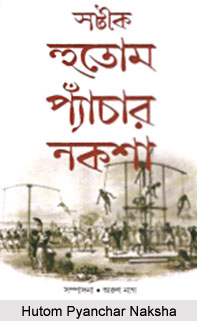 Hutom Pyanchar Naksha or `Naksha of the Owl` is a compilation of satirical prose by Kaliprasanna Sinha. It is a truly remarkable collection of around 140 pages` length, consisting in descriptions of religious festivals, false saints, Babus, Sahibs etc. Chalit Bhasha, colloquial language, is employed throughout Hutom Pyanchar Naksha.
Hutom Pyanchar Naksha or `Naksha of the Owl` is a compilation of satirical prose by Kaliprasanna Sinha. It is a truly remarkable collection of around 140 pages` length, consisting in descriptions of religious festivals, false saints, Babus, Sahibs etc. Chalit Bhasha, colloquial language, is employed throughout Hutom Pyanchar Naksha.
Hutom Pyanchar Naksha, as one of the outstanding literary works of nineteenth-century Bengal, found numerous imitators and established Naksha once and for all as a genre. The term Naksha, too, appears here to denote a satirical sketch written in prose and becomes customary from then on. In this sense, it marks the end of prose experiments and the beginning of a rather tightly knit tradition-that is, in one phrase, the end of the beginnings.
Kaliprasanna has given a form to an anarchy and variety of life that is synonymous with the rise, from the early 19th century, of Calcutta as a colonial and global metropolis, a city as yet without a notion of a great modern author (although two great moderns, Kaliprasanna himself and Michael Madhusudan Dutt, and their principal literary offerings, have, by now, in 1861, just come into existence); without a fixed and recognizable notion of Bengali literature (Bankim Chandra Chatterjee, who was quick to notice Kaliprasanna`s idiosyncratic genius, would write "A Popular Literature for Bengal" nine years later, lamenting its absence); or even a safe, working idea of Bengali culture, such as we take for granted today. Tagore, at this moment, is a newborn. Everything is transient, confusing, uncertain, and alive. It is not a culture comprising canons, or great authors and oeuvres, but pictures, posters, bulletins, scandals, and fads (what Sinha, in Hutom, calls hujuk). It`s an age given shape and diversion and colour by the pat and the bat-tala press. Hutom is not quite yet, in the year in which it sees the light of day, part of a proper `literature`, as you and I understand that word.



















